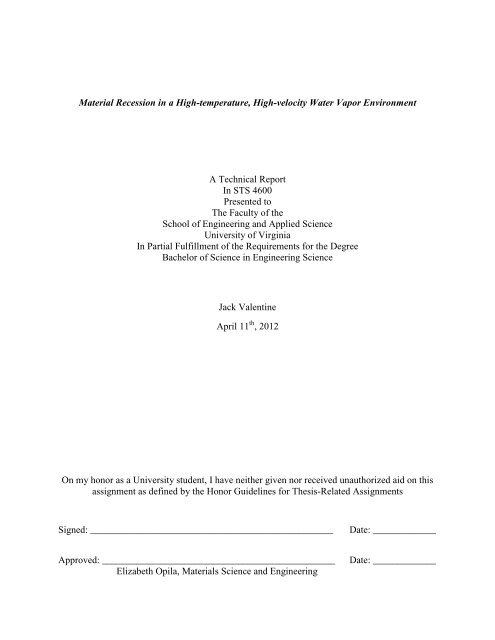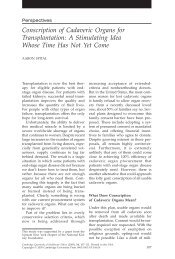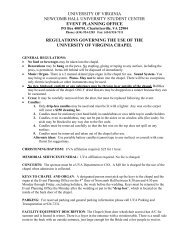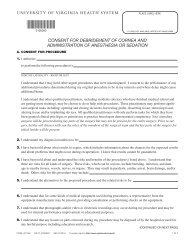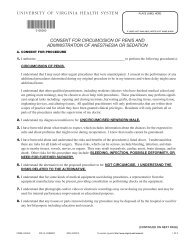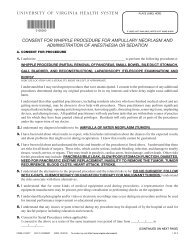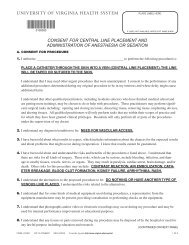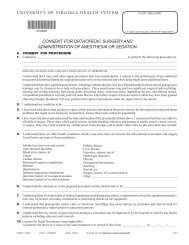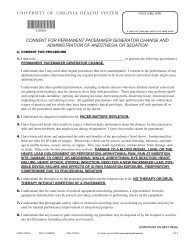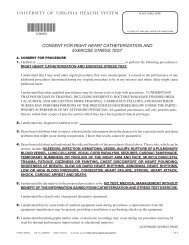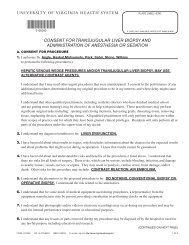Material Recession in a High-temperature, High-velocity Water ...
Material Recession in a High-temperature, High-velocity Water ...
Material Recession in a High-temperature, High-velocity Water ...
Create successful ePaper yourself
Turn your PDF publications into a flip-book with our unique Google optimized e-Paper software.
<strong>Material</strong> <strong>Recession</strong> <strong>in</strong> a <strong>High</strong>-<strong>temperature</strong>, <strong>High</strong>-<strong>velocity</strong> <strong>Water</strong> Vapor EnvironmentA Technical ReportIn STS 4600Presented toThe Faculty of theSchool of Eng<strong>in</strong>eer<strong>in</strong>g and Applied ScienceUniversity of Virg<strong>in</strong>iaIn Partial Fulfillment of the Requirements for the DegreeBachelor of Science <strong>in</strong> Eng<strong>in</strong>eer<strong>in</strong>g ScienceJack Valent<strong>in</strong>eApril 11 th , 2012On my honor as a University student, I have neither given nor received unauthorized aid on thisassignment as def<strong>in</strong>ed by the Honor Guidel<strong>in</strong>es for Thesis-Related AssignmentsSigned: __________________________________________________Date: _____________Approved: ________________________________________________Elizabeth Opila, <strong>Material</strong>s Science and Eng<strong>in</strong>eer<strong>in</strong>gDate: _____________
2AbstractA laboratory test<strong>in</strong>g device was created to simulate the environment of a combustionturb<strong>in</strong>e eng<strong>in</strong>e. Liquid water was pumped <strong>in</strong>to a furnace, moved through a small diametercapillary, vaporized and expelled as a gas at accelerated velocities. A SiO 2 sample was tested <strong>in</strong>the device for 170 hours at 1300°C and produced visible surface degradation due to avolatilization reaction which allowed estimations for the recession and weight loss rates. Therates were comparable to theoretical predictions. These results demonstrate the device’s capacityfor future test<strong>in</strong>g of potential eng<strong>in</strong>e materials <strong>in</strong> a low-cost laboratory sett<strong>in</strong>g.IntroductionFor combustion turb<strong>in</strong>e eng<strong>in</strong>es, <strong>in</strong>creased efficiency requires higher operat<strong>in</strong>g<strong>temperature</strong>s. 1 Hav<strong>in</strong>g reached the upper limits of current high-<strong>temperature</strong> metals, new ceramicmaterials, which offer the possibility of higher eng<strong>in</strong>e operation <strong>temperature</strong>, are required forfurther improvement <strong>in</strong> eng<strong>in</strong>e efficiencies. These materials still need significant characterizationbefore they can be implemented effectively <strong>in</strong>to designs. 2 The key problem with us<strong>in</strong>g ceramicsis they react with water vapor (a product of combustion reactions) and volatilize rapidly. 3 Thispaper outl<strong>in</strong>es a method for creat<strong>in</strong>g a laboratory test<strong>in</strong>g device that replicates a combustionenvironment.Silicon carbide (SiC) and similar ceramic composites are lead<strong>in</strong>g candidates for eng<strong>in</strong>eapplication due to their high <strong>temperature</strong> capability. However, SiC is prone to rapid deteriorationthrough the follow<strong>in</strong>g reactions with water vapor. 4( ) ( ) ( ) (1)( ) ( ) (2)
3As shown <strong>in</strong> Eqn. 1, the SiC reacts with water vapor to form an oxide layer (SiO 2 ). This oxidelayer then reacts with water vapor as shown <strong>in</strong> Eqn. 2 and volatilizes <strong>in</strong>to Si(OH) 4 . The high rateof these reactions can lead to severe material loss and has been well documented <strong>in</strong> the papers ofOpila 7 and Rob<strong>in</strong>son and Smialek. 8This paper focuses on a method for observ<strong>in</strong>g high-<strong>temperature</strong> materials’ reaction withwater vapor <strong>in</strong> an environment typical of combustion turb<strong>in</strong>es. Based on the design of dos Santoset al. 2 , Ferber and L<strong>in</strong> 5 and Sudhir and Raj 6 the objective is to create observable rapid recessionand compare the results with theoretical predictions.To observe these degradation mechanisms, there are several design objectives. Theoxidation mechanisms described <strong>in</strong> Eqn. 1 and 2 have a strong dependence on a variety of factors<strong>in</strong>clud<strong>in</strong>g: <strong>temperature</strong>, water vapor partial pressure, and gas flow <strong>velocity</strong>. 7 It is crucial toreplicate these factors of a combustion environment <strong>in</strong> the test<strong>in</strong>g device to create mean<strong>in</strong>gfulresults. This device will additionally act as a faster alternative to very expensive burner rig testsand allow for more precise control of <strong>in</strong>dependent variables. 2 It will also allow for observation ofthe reactions <strong>in</strong> a controlled environment.Experimental ProcedureThe test<strong>in</strong>g device design shown below <strong>in</strong> Fig. 1 uses a horizontal tube furnace (CMFurnaces Inc., Bloomfield, NJ, Model #100803) with a 1m long alum<strong>in</strong>a tube.Figure 1: Depiction of Test<strong>in</strong>g Device
̇4The sta<strong>in</strong>less steel end cap has two <strong>in</strong>let open<strong>in</strong>gs; the top one holds a fused quartz (SiO 2 )capillary through which liquid water is <strong>in</strong>jected and the bottom one holds a sheathedthermocouple (type R) which measures the <strong>temperature</strong> at the sample <strong>in</strong>teraction site. The fitt<strong>in</strong>gthat holds the capillary also has a T-fitt<strong>in</strong>g that can be used to <strong>in</strong>troduce additional permanentgases (e.g. Ar, O 2 ) <strong>in</strong> future test<strong>in</strong>g should it be necessary. The sheathed thermocouple (0.25”OD) runs through a hollow alum<strong>in</strong>a tube (0.875” OD) that acts as a support for the fused quartzcapillary. Without this support the fused quartz capillary bends and breaks under its own weightat high <strong>temperature</strong>s.The capillary used <strong>in</strong> this design has an outer diameter of 3mm and <strong>in</strong>ner diameter of1mm (Quartz Scientific, Inc., Fairport Harbor, OH). The capillary is cut to approximately 70cmso that when placed <strong>in</strong> the furnace, the exit open<strong>in</strong>g is at the end of the hot zone of the furnace.Liquid water is pumped <strong>in</strong>to the capillary us<strong>in</strong>g a peristaltic pump (IDEX Health & ScienceGmbH, Wertheim-Mondfeld, Germany, Ismatec Tub<strong>in</strong>g Pump Model REGLO Analog) at a rateof 1.8mL/m<strong>in</strong>. The water then travels through the capillary, enters the furnace, boils andaccelerates toward the sample as a gas. The gas <strong>velocity</strong> (v g ) of the water vapor was determ<strong>in</strong>edus<strong>in</strong>g an adaptation of the ideal gas law <strong>in</strong> the same way as dos Santos et al. 2 shown below(3)Where ṁ is the mass flow rate, R is the universal gas constant, T is the <strong>temperature</strong> of the jet, Ais the cross-sectional area of the capillary, MW is the molecular weight of water and P is the exitpressure at the end of the capillary. Us<strong>in</strong>g Eqn. 3 and assum<strong>in</strong>g: ambient pressure = 1 atm, MW= 18.015 g/mol; with test conditions of T = 1289 °C, A = 3.141E-6 m 2 , ṁ = 1.8 g/m<strong>in</strong>; a value ofv g = 272.4 m/s is obta<strong>in</strong>ed.
5The sample used <strong>in</strong> the test was a 1” x 1” SiO 2 slide(Quartz Scientific, Inc., Fairport Harbor, OH) that was chosento simulate the volatilization of the oxide layer shown <strong>in</strong> Eqn.2. The sample was placed <strong>in</strong> a slotted alum<strong>in</strong>a boat as shown <strong>in</strong>Fig. 2 and positioned <strong>in</strong> the furnace so that the gas wouldimp<strong>in</strong>ge directly onto the sample. The position<strong>in</strong>g of the samplewas determ<strong>in</strong>ed after calibration of the tube furnace<strong>temperature</strong> profile shown <strong>in</strong> Fig. 3. S<strong>in</strong>ce the furnace is 22”long, it is expected that the hot zone would be <strong>in</strong> the middle atFigure 2: View down tubefurnace (Digital Camera)the 11” mark. To give the wateradditional time to boil beforeexit<strong>in</strong>g the capillary, the end ofthe capillary was positioned atthe 13” mark and the slide waspositioned ½” from the end ofthe capillary.With this currentFigure 3: Furnace Calibrationconfiguration, the water exits the capillary with an audible sputter<strong>in</strong>g effect <strong>in</strong> which most of thewater transforms <strong>in</strong>to steam but there are sporadic bursts of liquid water through the furnace.Future tests will try to correct this issue by rais<strong>in</strong>g the liquid water <strong>temperature</strong> before enter<strong>in</strong>gthe furnace.
6Experimental ResultsThe sample shown <strong>in</strong> these results was exposed for 170 hours at 1289°C with a constantwater flow rate of 1.8 mL/m<strong>in</strong>. Unless noted otherwise, these images were taken with a digitalmicroscope (Hirox-USA, Inc., Hackensack, NJ, Model # KH 7700). The blue arrows <strong>in</strong>dicate thedirection of the water jet and the red-dashed l<strong>in</strong>es draw attention to material loss by outl<strong>in</strong><strong>in</strong>g theorig<strong>in</strong>al sample boundaries. Fig. 3 on the right shows the orientation of the sample <strong>in</strong> the furnacefrom the perspective of look<strong>in</strong>g down the tube. The quartz capillary rests on top of the alum<strong>in</strong>asupport cyl<strong>in</strong>der and expels water vapor directly at the sample slide.As Fig. 4 shows, there is a dist<strong>in</strong>ct difference between the slide before and after the furnacetest. The sample on the right has likely crystallized <strong>in</strong>to cristobalite. The <strong>in</strong>teraction site betweenthe water vapor jet and sample is also evident <strong>in</strong> the top right corner of the sample. By weigh<strong>in</strong>gthe sample before and after the furnace run, a weight loss equal to 0.07908 g was calculated.Figure 4: Comparison of SiO 2 slide before and after exposure (Digital Camera)
7Fig. 5 gives a more detailed perspective of the<strong>in</strong>teraction site of the water vapor and the sample.The sample recession is evident and theobservable area of material loss on the front sideof the slide (outl<strong>in</strong>ed <strong>in</strong> green) is approximately0.5 cm 2 .This sample also showed visible recessionwhen viewed from a top perspective. As Fig. 6Figure 5: Front view of SiO 2 Slide afterfurnace exposuredepicts, the red dashed l<strong>in</strong>e is the approximate dimensions of the sample prior to the run and thechange <strong>in</strong> the width of the slide from the lead<strong>in</strong>g edge backwards is evident.Figure 6: Top view of SiO 2 slide after furnace exposureThe po<strong>in</strong>t of greatest recession is at the lead<strong>in</strong>g edge and shows a width change of 126 µm. S<strong>in</strong>cethis test was run for 170 hours, this produces a maximum recession rate of approximately 0.74µm/hr.Discussion of ResultsTo determ<strong>in</strong>e the accuracy of these results and the effectiveness of the device, it is necessary tocompare the results to theoretical models and predictions of material loss. Us<strong>in</strong>g the equationdeveloped by Rob<strong>in</strong>son and Smialek 8 for SiC, which is shown below <strong>in</strong> Eqn. 4, an expectedweight loss rate (k l ) is calculated for SiO 2 (neglect<strong>in</strong>g the density difference between SiO 2 and
8SiC) based on the <strong>velocity</strong> (v), <strong>temperature</strong> (T), and partial pressure (P) of the water vapor andother environmental conditions.( ) (( )) (4)By us<strong>in</strong>g values of T=1562 K, v = 272.4 m/s and assum<strong>in</strong>g P=1 atm, this gives us a value of k 1 =0.1373 mg/(cm 2·hr). For comparison, an experimental value determ<strong>in</strong>ed from the observedweight loss and affected area on the sample is calculated with Eqn. 5.( ) ( ) (5)Where m is mass loss, A is area of mass loss and t is time of exposure, Us<strong>in</strong>g <strong>in</strong>put for m =0.07908 g, A = 1 cm 2 (for the two sides of the slide) and t = 170 hours; it is found that k 1 =0.4652 mg/(cm 2·hr).The calculated and measured l<strong>in</strong>ear weight loss rates, k, differ by a factor of 3.38 but theorder of magnitude is correct. The discrepancy may be attributed to the rough estimation of theaffected surface area and the density difference between SiO 2 and SiC which was neglected. Thiscomparison gives the semi-quantitative confirmation that the test<strong>in</strong>g device provides a realisticsimulation of the water vapor flows common to combustion environments.SummaryThis furnace water jet provides an <strong>in</strong>expensive test<strong>in</strong>g device for characteriz<strong>in</strong>g materials’<strong>in</strong>teractions with high-<strong>temperature</strong> water vapor under controlled and <strong>in</strong>dependently variable<strong>temperature</strong>s and gas velocities. The results for SiO 2 show rapid and measurable materialrecession that agree with theoretical predictions. This device will enable a more comprehensiveunderstand<strong>in</strong>g of the basic science beh<strong>in</strong>d high-<strong>velocity</strong>, high-<strong>temperature</strong> water vapor


